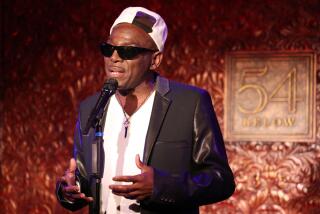BOLGER LEGACY DANCES ON
- Share via
Once upon a decade, before television began to gnaw at Life’s vitals, the magazine treated the staff to a large Christmas party in the Rainbow Room atop the RCA Building. One year, before he went along to the night’s performance of “Where’s Charley?,” Ray Bolger came by.
While all of us stood in a great circle around the dance floor, Bolger sang and danced “Once in Love With Amy,” which then, as now, seems to me one of the most amiable musical valentines ever sent.
In that relaxed, lighter-than-air, loose-limbed style of his--he sometimes appeared to have an enlarged quota of knees and elbows--Bolger glided around the floor, soft of shoe and soft of voice. He bowed to a couple of the ladies on the staff and, not missing a beat, gave each of them a few pleasing swirls.
It was a lovely moment, and as the greenest trainee on the staff, I felt as if I were living beyond my fattest dreams of big-city life. Thinking back, I have no doubt that even the senior staff felt the same way. And when Ray Bolger died last week at the age of 83, I’m sure I’m not the only one who thought first of that impromptu, indelible performance above the lights of Manhattan.
It is ironic that he goes into history as The Scarecrow, Dorothy’s last surviving companion from the Yellow Brick Road to Oz. It’s a deserved tribute to the chemistry, the alchemy really, of that remarkable quartet--Judy Garland, Jack Haley, Bert Lahr and Bolger--and the skills of the creators who set them in motion.
Yet Bolger left far more than a one-role legacy. He won the 1949 Tony for his acting, singing and dancing in “Where’s Charley?,” and he was one of that never-large company of hoofers who emerged from their long, hard apprenticeships as more than hoofers.
Like Jimmy Cagney, Fred Astaire, Gene Kelly and Donald O’Connor, Bolger turned out to be an engaging singer and an able actor whose range was not limited to musical comedy. Perhaps in part because Cagney and Astaire got there first, and partly because he had such strong ties to the theater, Bolger did less in Hollywood than he should have--and it is too bad.
He was his own man, with a public persona that was different yet again from Cagney’s street-kid brashness, Astaire’s debonair charm, Kelly’s vigorous mid-American enthusiasm, O’Connor’s comedic energy. Bolger was less easy to pin down: He could be funny and charming and silly, but there was also a reserve about him, an intimation of wistful, thoughtful melancholy.
In later years I met him here in Los Angeles and had a chance to express my slightly belated thanks for that wonderful evening in the Rainbow Room. He remembered the evening with pleasure as well, and he was the modest, gracious man I had expected him to be.
It’s always seemed to me that the extreme self-discipline it takes to be very good at certain things--competitive swimming, animation, playing a musical instrument, dancing--quickly weeds out the half-hearted and the also-rans. Those who survive the course have a particular kind of confidence, because they know what they can do and know it has been no accident; and they have an inner serenity because they have put themselves to the test and passed.
There may be frustrations, creative and otherwise; there always are. Yet even in the late-20th Century, you can make the case that hard work is still its own reward. And what occurs to me as I think about Bolger and the effortless nonchalance of his dancing was that it evolved from those uncountable hours of practice in the parlor, and from those hard nights of trying to win over the thin audiences in drafty vaudeville houses.
These days there are dance studios on every boulevard; whether a new Ray Bolger lurks in one of them is not certain.
More to Read
The biggest entertainment stories
Get our big stories about Hollywood, film, television, music, arts, culture and more right in your inbox as soon as they publish.
You may occasionally receive promotional content from the Los Angeles Times.










